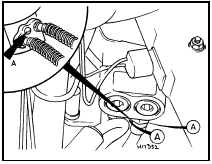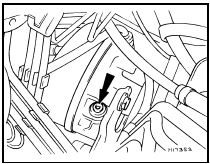Hydraulic system - bleeding (anti-lock braking system)
Note: Before starting work, refer to the warning at the beginning of Section 11 concerning the dangers of hydraulic fluid.
1 On cars equipped with the anti-lock braking system there are two bleed procedures possible according to which part of the hydraulic system has been disconnected.
2 If any one of the following conditions are
present, bleed procedure A should be
adopted:
a) A modulator has been removed.
b A modulator-to-master cylinder return hose has been drained.
c) The two modulator hydraulic hoses have been removed.
3 If any one of the following conditions are
present, bleed procedure B should be
adopted:
a) Any condition where the master cylinder
has been drained providing that the
modulator fluid return pipe has not lost its
head of fluid.
b) Removal of any of the basic braking system components ie brake caliper, flexible hose or pipe, wheel cylinder, load apportioning valve.
Bleed procedure A
4 Top-up the master cylinder reservoir to the
“MAX” mark using the specified type of fluid
and keep it topped up throughout the bleed
procedure.
5 Using a Torx type key or socket bit slacken the bypass valve on the relevant modulator by one to one and a half turns. The bypass valve is located between the two flexible hoses on the side of the modulator (see illustration).

23.5 Modulator bypass valve (A) location
6 Fully depress and hold depressed the auto bleed plunger on the modulator so that the plunger circlip contacts the modulator body (see illustration).

23.6 Modulator auto bleed plunger location (arrowed)
7 Have an assistant steadily pump the brake pedal at least twenty times while you observe the fluid returning to the master cylinder reservoir. Continue this operation until the returning fluid is free from air bubbles.
8 Release the auto bleed plunger ensuring that it has fully returned. Pull it out by hand if necessary.
9 Tighten the bypass valve on the modulator.
10 Now carry out bleed procedure B.
Bleed procedure B
11 This procedure is the same as for
conventional braking systems and reference
should be made to Section 11. Note,
however, that all the weight of the car must be
on the roadwheels, not suspended wheel free,
otherwise the load apportioning valves will not
bleed.
See also:
Engine/manual gearbox assembly - reconnection and refitting
1 Reverse the procedure described in
paragraphs 1 to 33 of Section 7, noting the
following points.
2 Before attempting to reconnect the engine
to the gearbox, check that the clutch friction
disc ...
Hydraulic pipes and hoses - renewal
Note: Before starting work, refer to the
warning at the beginning of Section 3
concerning the dangers of hydraulic fluid.
1 Always disconnect a flexible hose by
prising out the spring anchor clip ...
Ignition switch - removal and refitting
Pre-1986 models
Removal
1 Disconnect the battery, undo the screws
and remove the steering column lower
shroud.
2 Insert the ignition key into the lock and turn
it to position I.
3 Using a flat- ...
